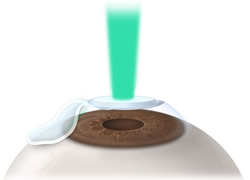LASEK
 LASEK, also known as Laser Epithelial Keratomileusis, is a laser vision correction procedure that is recommended for patients with very thin or very steep corneas.
LASEK, also known as Laser Epithelial Keratomileusis, is a laser vision correction procedure that is recommended for patients with very thin or very steep corneas.
More of the cornea is exposed for treatment with LASEK than with LASIK, making LASEK a better choice for patients who require greater vision correction. LASEK does require a longer period of recovery.
The LASEK Procedure
An extremely thin layer of the epithelium, the outer layer of the cornea, is removed with a microsurgical instrument known as a trephine. The eye is then bathed with a special alcohol solution that loosens the edge of the epithelium to allow for the creation of an epithelial flap. The epithelial flap is created and lifted aside so that the central cornea is exposed for treatment with an excimer laser. After the laser treatment, the epithelial flap is put back in place and covered with a soft contact lens so that the eye may heal. The contact lens will be worn for a few days until recovery is complete.
Risks and Complications of the LASEK Procedure
During the post-operative recovery period, patients may experience some discomfort which may be alleviated by over-the-counter pain medication.
